Jiahu Qin
Safety-critical Control with Control Barrier Functions: A Hierarchical Optimization Framework
Oct 21, 2024Abstract:The control barrier function (CBF) has become a fundamental tool in safety-critical systems design since its invention. Typically, the quadratic optimization framework is employed to accommodate CBFs, control Lyapunov functions (CLFs), other constraints and nominal control design. However, the constrained optimization framework involves hyper-parameters to tradeoff different objectives and constraints, which, if not well-tuned beforehand, impact system performance and even lead to infeasibility. In this paper, we propose a hierarchical optimization framework that decomposes the multi-objective optimization problem into nested optimization sub-problems in a safety-first approach. The new framework addresses potential infeasibility on the premise of ensuring safety and performance as much as possible and applies easily in multi-certificate cases. With vivid visualization aids, we systematically analyze the advantages of our proposed method over existing QP-based ones in terms of safety, feasibility and convergence rates. Moreover, two numerical examples are provided that verify our analysis and show the superiority of our proposed method.
Get It For Free: Radar Segmentation without Expert Labels and Its Application in Odometry and Localization
Sep 27, 2024Abstract:This paper presents a novel weakly supervised semantic segmentation method for radar segmentation, where the existing LiDAR semantic segmentation models are employed to generate semantic labels, which then serve as supervision signals for training a radar semantic segmentation model. The obtained radar semantic segmentation model outperforms LiDAR-based models, providing more consistent and robust segmentation under all-weather conditions, particularly in the snow, rain and fog. To mitigate potential errors in LiDAR semantic labels, we design a dedicated refinement scheme that corrects erroneous labels based on structural features and distribution patterns. The semantic information generated by our radar segmentation model is used in two downstream tasks, achieving significant performance improvements. In large-scale radar-based localization using OpenStreetMap, it leads to localization error reduction by 20.55\% over prior methods. For the odometry task, it improves translation accuracy by 16.4\% compared to the second-best method, securing the first place in the radar odometry competition at the Radar in Robotics workshop of ICRA 2024, Japan
PE-Planner: A Performance-Enhanced Quadrotor Motion Planner for Autonomous Flight in Complex and Dynamic Environments
Mar 19, 2024
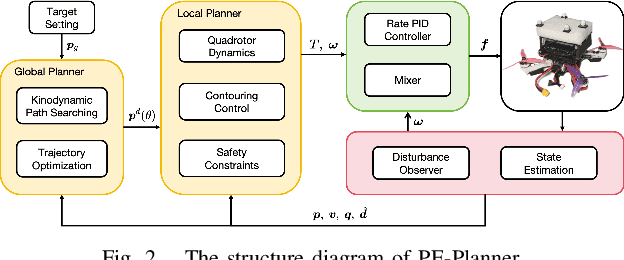

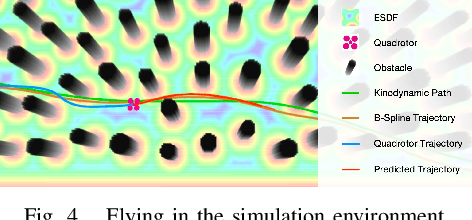
Abstract:The role of a motion planner is pivotal in quadrotor applications, yet existing methods often struggle to adapt to complex environments, limiting their ability to achieve fast, safe, and robust flight. In this letter, we introduce a performance-enhanced quadrotor motion planner designed for autonomous flight in complex environments including dense obstacles, dynamic obstacles, and unknown disturbances. The global planner generates an initial trajectory through kinodynamic path searching and refines it using B-spline trajectory optimization. Subsequently, the local planner takes into account the quadrotor dynamics, estimated disturbance, global reference trajectory, control cost, time cost, and safety constraints to generate real-time control inputs, utilizing the framework of model predictive contouring control. Both simulations and real-world experiments corroborate the heightened robustness, safety, and speed of the proposed motion planner. Additionally, our motion planner achieves flights at more than 6.8 m/s in a challenging and complex racing scenario.
SRL-ORCA: A Socially Aware Multi-Agent Mapless Navigation Algorithm In Complex Dynamic Scenes
Jun 18, 2023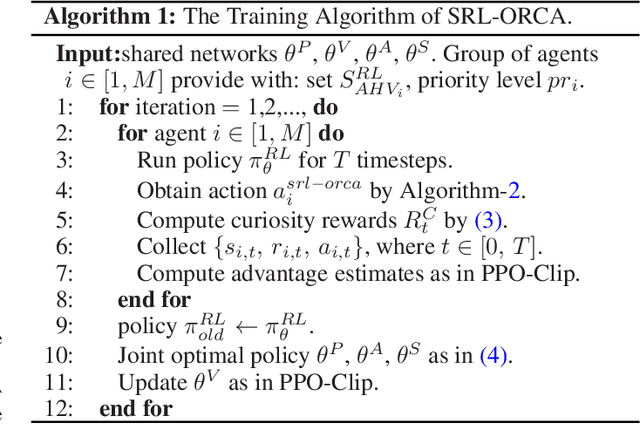


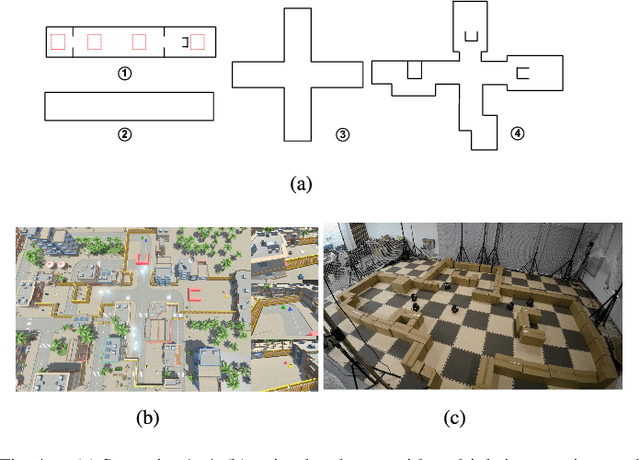
Abstract:For real-world navigation, it is important to endow robots with the capabilities to navigate safely and efficiently in a complex environment with both dynamic and non-convex static obstacles. However, achieving path-finding in non-convex complex environments without maps as well as enabling multiple robots to follow social rules for obstacle avoidance remains challenging problems. In this letter, we propose a socially aware robot mapless navigation algorithm, namely Safe Reinforcement Learning-Optimal Reciprocal Collision Avoidance (SRL-ORCA). This is a multi-agent safe reinforcement learning algorithm by using ORCA as an external knowledge to provide a safety guarantee. This algorithm further introduces traffic norms of human society to improve social comfort and achieve cooperative avoidance by following human social customs. The result of experiments shows that SRL-ORCA learns strategies to obey specific traffic rules. Compared to DRL, SRL-ORCA shows a significant improvement in navigation success rate in different complex scenarios mixed with the application of the same training network. SRL-ORCA is able to cope with non-convex obstacle environments without falling into local minimal regions and has a 14.1\% improvement in path quality (i.e., the average time to target) compared to ORCA. Videos are available at https://youtu.be/huhXfCDkGws.
Distributed Coverage Control of Constrained Constant-Speed Unicycle Multi-Agent Systems
Apr 12, 2023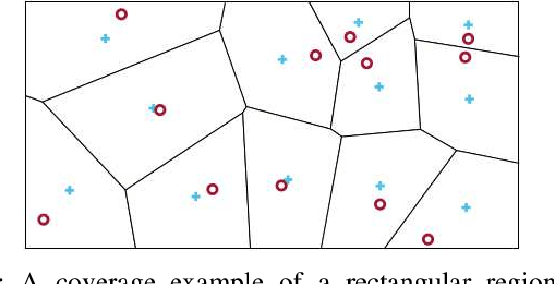
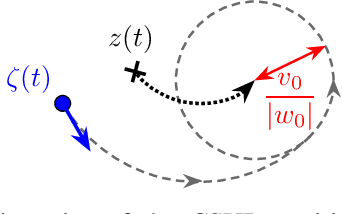
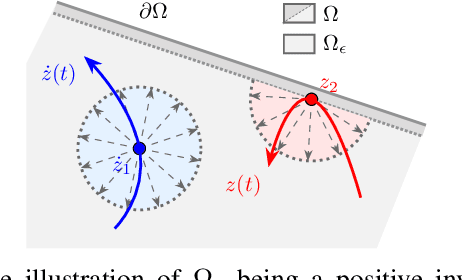
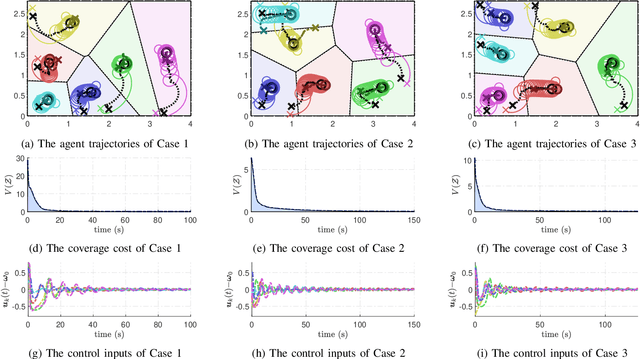
Abstract:This paper proposes a novel distributed coverage controller for a multi-agent system with constant-speed unicycle robots (CSUR). The work is motivated by the limitation of the conventional method that does not ensure the satisfaction of hard state- and input-dependent constraints and leads to feasibility issues for multi-CSUR systems. In this paper, we solve these problems by designing a novel coverage cost function and a saturated gradient-search-based control law. Invariant set theory and Lyapunov-based techniques are used to prove the state-dependent confinement and the convergence of the system state to the optimal coverage configuration, respectively. The controller is implemented in a distributed manner based on a novel communication standard among the agents. A series of simulation case studies are conducted to validate the effectiveness of the proposed coverage controller in different initial conditions and with control parameters. A comparison study in simulation reveals the advantage of the proposed method in terms of avoiding infeasibility. The experiment study verifies the applicability of the method to real robots with uncertainties. The development procedure of the method from theoretical analysis to experimental validation provides a novel framework for multi-agent system coordinate control with complex agent dynamics.
 Add to Chrome
Add to Chrome Add to Firefox
Add to Firefox Add to Edge
Add to Edge